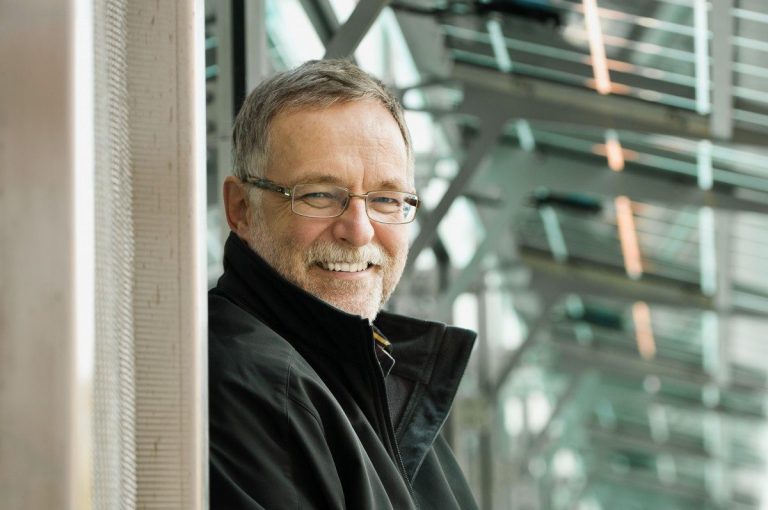Rather than burying their heads in books, students in Professor John Robinson’s joint undergraduate/graduate “U of T as a Living Lab of Sustainability” course are actively contributing to the improvement, usability and efficiency of the spaces they use on campus.
Appointed to Geography & Planning, the Munk School of Global Affairs & Public Policy, the School of the Environment, and the graduate faculty of the John H. Daniels Faculty of Architecture and Design, Robinson offers a unique experiential learning opportunity in his course by pairing students with “clients” — U of T staff who manage the operational functions of the University — to take on infrastructural improvement, from architecture to waste disposal to irrigation and more.
One undergraduate student group conducted an evaluation of the Sidney Smith Commons, a recent Arts & Science initiative to create a multi-use space for meeting, studying, relaxing and accessing help and resources.
But what exactly were the students looking for?
A people-centric sustainable space

“Sustainability is about human well-being, as well as environmental,” says Robinson, explaining a holistic and inclusive definition of sustainability. In this context, the Sidney Smith Commons evaluation looked at the actual lived experiences of people using the space, asking about their levels of comfort, personal well-being, and senses of community and belonging.
A survey designed by Sylvia Coleman, a postdoctoral researcher at the John H. Daniels Faculty of Architecture, Landscape and Design, in consultation with the client was an integral part of the evaluation.
In addition to questions like “Do you have access to an electrical outlet where you are sitting?” and requests to rate lighting, temperature and air quality, the survey also asked qualitative questions like “Do you feel a sense of belonging in this space?” and “How does this space enable you to do what you want?”
The results of the survey brought about iterative adjustments to things like room temperature and improved access to electrical outlets. Overall, the students evaluating the Commons found that people using the space reported above-average productivity and well-being, goals which were integral to the development of the space at the outset.
“We wanted to create an environment that inspires innovation and collaboration,” says Associate Faculty Registrar and Director of Student Affairs Erin McMichael.
The goal was to build a space that “supports the way students learn and interact in a way that is flexible, accessible, sustainable, and technologically advanced. We also strived to create a space that fosters community and a sense of belonging.”
We wanted to create an environment that inspires innovation and collaboration.
It may seem unconventional to highlight human well-being as an aspect of sustainability, but this kind of expanded, people-centric conception of sustainability is integral to Robinson’s research and teaching.
Michelle Chia, an undergraduate student in her final year majoring in employment relations and environmental studies, worked on the Commons project and said Robinson’s class “opened up my eyes to sustainability in terms of people and their well-being in spaces,” she says. “This gave me another perspective — to not just think of the environment, but people too.”
In addition to a human-centred angle, Robinson also promotes a distinctly optimistic conception of sustainability. “Let’s not just talk about cutting back and reducing harm,” he says. “Let’s talk about how things could be better. Take a building: is the goal to reduce energy and to reduce carbon emissions to zero? Or is the goal to actually improve the environment, to improve human well-being?”
The university campus as “living lab”
In increasing numbers of projects like this one, the campus is envisioned as a “living lab,” a place where sustainability projects combine operational and academic activities. The Commons is “one of only a handful of university-wide living lab initiatives that came out of the President’s Advisory Committee on the Environment, Climate Change, and Sustainability,” says McMichael.
In the living lab, “students are doing stuff that they would never do in an ordinary course,” says Robinson, who is also the committee’s chair, as well as the president’s advisor on environment, climate change and sustainability.
“Yes, they’re reading literature, but they’re also collecting data; they’re dealing with clients and their operational needs. That’s the key thing about this course: I don’t come up with the problems. The clients decide what students do. This course exposes students to a different kind of knowledge; very applied, problem-oriented, real-world knowledge.”
This course exposes students to a different kind of knowledge; very applied, problem-oriented, real-world knowledge.
“We had to be adaptable to changing circumstances,” says Chia, “which typically doesn’t happen with a lot of projects in school. Accomplishing the study but also ensuring the client was happy was really important.”
Lauren Tom, another student who worked on the Commons evaluation, echoes the real-world value of the project: there’s a false notion that students “don’t have the agency to effect change — you have to wait until you’re older, until you have more connections, more experience, etc. However, everything about this class challenged this conviction. Professor Robinson and our clients made it quite clear to us that our efforts were valuable and that we were making significant, real contributions.”
Alongside a people-centric portrait of sustainability, Robinson also advocates for collaboration across academic disciplines, so that everyone from engineers to philosophers, sociologists to architects can enter into productive discussions with each other.
“You have to go through an immersive experience to understand someone else’s discipline,” says Robinson. “What you need to learn is not how to write in different fields — because you can’t — but to read in multiple fields. And to talk — to be able to make sense.”
Robinson’s students have benefited from his expanded, malleable, and people-centric notions of sustainability, interdisciplinarity and the campus as a “living lab.” The student group who worked on the Commons evaluation is well-poised to pursue their chosen career goals: from journalism to education to business and beyond.

